Jack Bechtold, Noah Stommel, Wyatt Kowalchuk
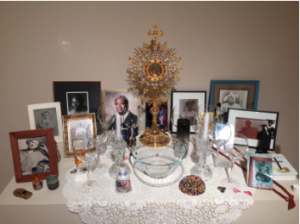
Professor Matory’s Spiritist Altar
As one enters the “Spirited Things” exhibit at the Fleming Museum, an altar belonging to Professor Lorand Matory adorned with framed portraits and wine glasses comes into focus. A plaque beside the altar indicates that Spiritism or Espiritismo, to which this altar belongs, is an African diasporic religion most practiced in Brazil, Cuba, Puerto Rico, and the Dominican Republic. Throughout the centuries since the slave trade, multiple religions from a variety of cultures have syncretized to form Spiritism, including those of Native Americans, Africans, and Europeans. Further elaborated upon by the museum plaque is that Spiritism has a foundation based heavily on the writings of a nineteenth century Frenchman named Allan Kardec. Spiritism is a highly variable religion of syncretized traditions, in which we see practitioners following a religious base that can express itself in different ways. The core of Spiritism focuses on the dead, and how one can connect the spiritual world with the human world to solve problems.
Known for “generating a niche of practice premised on a loose set of common assumptions regarding the realm of spirits and its influences on the living” (Santo 4, 2015), Spiritist altars provide a sense of both conventional religiosity and personal reverence for ancestors. Espiritistas or Spiritists, profess to receive authentic spiritual insights through visions and dreams directly from God. There is no reason for them to believe that their religious communications are a result of the combinations seen between the many cultures present in New World nations (Romberg 77, 1998). Practitioners believe Spiritism is ultimately an independent religion, and not just a hybrid resulting from various other cultures. However, this brings us to an important observation that considers how Spiritism puts emphasis on the reverence of one Christian God. As inspired by Kardec’s writings, the God seen in Christianity is to be the ultimate spiritual form of intelligence in the universe, and all spirits who are fundamentally worshipped by Spiritists are manifestations of God (Romberg 71, 1998). Another prime example of how multiple cultures have mixed to form Spiritism is in the case of Christian saints representing West-African Orisha equivalents in rituals (Garoutte & Wambaugh 158, 2007). Not only have European and African traditions undergone mixing, but they have come to mirror one another, intertwining in such a way that religious figures are paralleled.
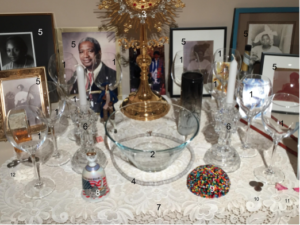 The syncretic qualities of Spiritism allow us to gain an understanding of where certain Spiritist values are derived from. Spiritism is oriented around communication with ancestors that often takes place in the form of spirit possession (Bettelheim 314-315, 2005). Interestingly, this core value of Spiritist belief in communication with ancestors is believed to have been a result of syncretization with Native American cultures (Romberg 70,1998). In connection to syncretization, altar construction is considered “fluid, mixing a variety of religious systems and iconographies and inventing new ones” (Bettelheim 314, 2005), hence the inclusion of objects of apparent Christian origin, like Object 3 on Professor Matory’s altar. An element of these altars that is chiefly Spiritist is the horizontal layout as represented by Object 7. As a practitioner becomes more experienced, the altar will become more adorned with objects, often involving portraits of the ancestors who are to be worshipped (Bettelheim 315, 2005). Professor Matory’s altar honors his and his wife’s ancestors, who are rendered present through objects and photos.
The syncretic qualities of Spiritism allow us to gain an understanding of where certain Spiritist values are derived from. Spiritism is oriented around communication with ancestors that often takes place in the form of spirit possession (Bettelheim 314-315, 2005). Interestingly, this core value of Spiritist belief in communication with ancestors is believed to have been a result of syncretization with Native American cultures (Romberg 70,1998). In connection to syncretization, altar construction is considered “fluid, mixing a variety of religious systems and iconographies and inventing new ones” (Bettelheim 314, 2005), hence the inclusion of objects of apparent Christian origin, like Object 3 on Professor Matory’s altar. An element of these altars that is chiefly Spiritist is the horizontal layout as represented by Object 7. As a practitioner becomes more experienced, the altar will become more adorned with objects, often involving portraits of the ancestors who are to be worshipped (Bettelheim 315, 2005). Professor Matory’s altar honors his and his wife’s ancestors, who are rendered present through objects and photos.
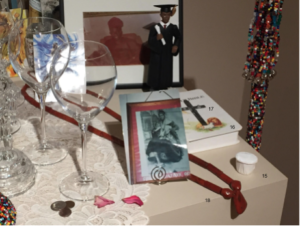 Spiritism holds emphasis on the idea that connecting to one’s ancestors through mediumship is highly individual to the practitioner both in terms of method and the spirits themselves who are involved (Santo 4, 2015). Therefore, each practitioner’s Spiritist altar will be constructed differently according to their connections with their own ancestors. The particular altar under observation in the Fleming Museum was constructed under Professor Lorand Matory and his own espiritista, who serves as an altar-builder. His altar will therefore be highly individual to his ancestors and the way he chooses to represent and communicate with them. Of course, there are certain aspects of the altar that make it recognizable to Spiritist tradition. First of all, many of these altars will try to stimulate the presence of ancestors by ladening a table with offerings of items such as water and flowers (Santo 35, 2015), both of which are present on this altar.
Spiritism holds emphasis on the idea that connecting to one’s ancestors through mediumship is highly individual to the practitioner both in terms of method and the spirits themselves who are involved (Santo 4, 2015). Therefore, each practitioner’s Spiritist altar will be constructed differently according to their connections with their own ancestors. The particular altar under observation in the Fleming Museum was constructed under Professor Lorand Matory and his own espiritista, who serves as an altar-builder. His altar will therefore be highly individual to his ancestors and the way he chooses to represent and communicate with them. Of course, there are certain aspects of the altar that make it recognizable to Spiritist tradition. First of all, many of these altars will try to stimulate the presence of ancestors by ladening a table with offerings of items such as water and flowers (Santo 35, 2015), both of which are present on this altar.
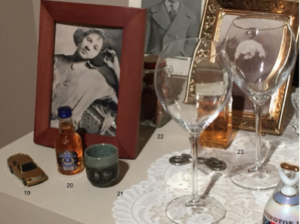 It is important to acknowledge the individualism of each Spiritist altar. Around the perimeter of the raised table are the many counterparts of Object 5, representative of the ancestors of both Professor Matory and his wife, with a considerably smaller Object 33. These old photographs are clear representations of the spirits who are being invoked through the activation of this altar. Object 7, which serves as the platform for the altar, is adorned with the ten glasses that comprise Object 1, presumably one for each ancestor. Here we see a relative lack of activation context, for the reason that there is not water in any of the glasses. As the altar’s plaque states, constant replenishment of the water is a vital method for summoning the ancestors’ spirits, and the formation of bubbles in the water signifies successful communication with spirits. However, without proper stimulation of the altar, we simply view its outer, physical skeleton, which lacks any spiritual interventions.
It is important to acknowledge the individualism of each Spiritist altar. Around the perimeter of the raised table are the many counterparts of Object 5, representative of the ancestors of both Professor Matory and his wife, with a considerably smaller Object 33. These old photographs are clear representations of the spirits who are being invoked through the activation of this altar. Object 7, which serves as the platform for the altar, is adorned with the ten glasses that comprise Object 1, presumably one for each ancestor. Here we see a relative lack of activation context, for the reason that there is not water in any of the glasses. As the altar’s plaque states, constant replenishment of the water is a vital method for summoning the ancestors’ spirits, and the formation of bubbles in the water signifies successful communication with spirits. However, without proper stimulation of the altar, we simply view its outer, physical skeleton, which lacks any spiritual interventions.
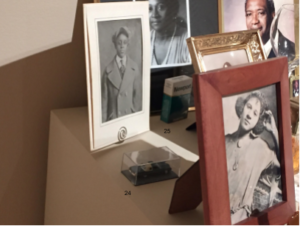 Object 2 is placed at the center of these symmetrically-set wine glasses, which will serve the same purpose in summoning spirits once filled with water. The symmetry that is overall apparent in the altar is created by the espiritista. Depending on the altar, the espiritista will “make a personal altar assemblage within a certain recognizable frame” (Bettelheim 314, 2005). Wrapped around the base of Object 2 is Object 4, which serves to represent the dansea, or chief, of a tribe. This is the dansea of Professor Matory’s maternal grandfather. Other objects on the platform intended to uplift the spirits of deceased relatives include Object 6, which once lit causes true spirit activation. Object 13, which lies on the ground and is made of ground egg shells, shares the purpose of summoning deceased spirits. Paired with these lines is Object 15, known as cascarilla, also made of ground egg shells.
Object 2 is placed at the center of these symmetrically-set wine glasses, which will serve the same purpose in summoning spirits once filled with water. The symmetry that is overall apparent in the altar is created by the espiritista. Depending on the altar, the espiritista will “make a personal altar assemblage within a certain recognizable frame” (Bettelheim 314, 2005). Wrapped around the base of Object 2 is Object 4, which serves to represent the dansea, or chief, of a tribe. This is the dansea of Professor Matory’s maternal grandfather. Other objects on the platform intended to uplift the spirits of deceased relatives include Object 6, which once lit causes true spirit activation. Object 13, which lies on the ground and is made of ground egg shells, shares the purpose of summoning deceased spirits. Paired with these lines is Object 15, known as cascarilla, also made of ground egg shells.
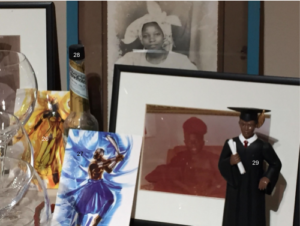 Some of the objects clearly show the syncretic aspects of Spiritism, such as Objects 9 and 14. Both of these objects pay tribute to the influence that Yoruba-inspired traditions have in Professor Matory’s household. Object 9 is an object in which a practitioner would pour alcohol or water in reverence to an Orisha (Awolalu 24, 1970). Object 14 closely resembles an artifact as seen in the Duke University art collection that is used to symbolize the support bestowed on a worshipper by a particular Orisha (Duke University, 2017). Also noticeable towards the rear of the table are Objects 26 and 27. Ogum and Oxum are explained to be Professor Matory’s head Orixa, and therefore they require a seat on the table next to his ancestors. As a side note, Professor Matory, alluded to the significance of Candomblé in the setup of this altar. Noticing that the names of these Orisa, or Orixa, are spelled in the Brazilian fashion (Johnson xi, 2002), we can see an example of Spiritist-Candomblé overlap. Perhaps most obviously, Object 3, a product of Roman Catholicism, which also has an integral role to play in the syncretic nature of Spiritism, sits near the center of the altar. To further the connection to Christianity are Objects 16, which was a gift to Professor Matory’s wife’s parents upon his wedding, and 17, which again shows the significance in the reverence for Christian figures in Spiritist practice.
Some of the objects clearly show the syncretic aspects of Spiritism, such as Objects 9 and 14. Both of these objects pay tribute to the influence that Yoruba-inspired traditions have in Professor Matory’s household. Object 9 is an object in which a practitioner would pour alcohol or water in reverence to an Orisha (Awolalu 24, 1970). Object 14 closely resembles an artifact as seen in the Duke University art collection that is used to symbolize the support bestowed on a worshipper by a particular Orisha (Duke University, 2017). Also noticeable towards the rear of the table are Objects 26 and 27. Ogum and Oxum are explained to be Professor Matory’s head Orixa, and therefore they require a seat on the table next to his ancestors. As a side note, Professor Matory, alluded to the significance of Candomblé in the setup of this altar. Noticing that the names of these Orisa, or Orixa, are spelled in the Brazilian fashion (Johnson xi, 2002), we can see an example of Spiritist-Candomblé overlap. Perhaps most obviously, Object 3, a product of Roman Catholicism, which also has an integral role to play in the syncretic nature of Spiritism, sits near the center of the altar. To further the connection to Christianity are Objects 16, which was a gift to Professor Matory’s wife’s parents upon his wedding, and 17, which again shows the significance in the reverence for Christian figures in Spiritist practice.
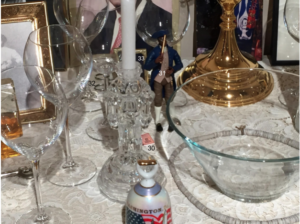 Most of the remaining objects comprise a collection that is personal to Professor Matory in either a symbolic or heritable sense. They are in other words, “aesthetic” objects put on the altar out of preference and personal necessity. Two figurines stand on the table, represented by Objects 29 and 30. These figurines were gifts to Professor Matory and are significant to him because of his family’s dedication to education and scholarship. To complement Object 30, which is supposed to depict Benjamin Banneker, is a diminutive copy of an almanac published by him in the 18th century. It is important to also note the significance in race portrayal seen in these figurines. Racial pride and mobility are seen not only with these objects, but also with Object 34, which shows a more mainstream representation of African American racial empowerment.
Most of the remaining objects comprise a collection that is personal to Professor Matory in either a symbolic or heritable sense. They are in other words, “aesthetic” objects put on the altar out of preference and personal necessity. Two figurines stand on the table, represented by Objects 29 and 30. These figurines were gifts to Professor Matory and are significant to him because of his family’s dedication to education and scholarship. To complement Object 30, which is supposed to depict Benjamin Banneker, is a diminutive copy of an almanac published by him in the 18th century. It is important to also note the significance in race portrayal seen in these figurines. Racial pride and mobility are seen not only with these objects, but also with Object 34, which shows a more mainstream representation of African American racial empowerment.
Further objects on the table include Object 32, that belonged to Professor Matory’s father during his working days. While paying tribute to his father, Object 32 may also represent an aspect of advanced levels of education, the highly prized attribute in the Matory household. Object 21 is also a material tribute to his father. This item is symbolic because it was something that was brought back from Japan upon the birth of Professor Matory’s sister. Another representation is seen in Object 18, a personal belonging of Professor Matory’s father that is draped across the front of the altar.
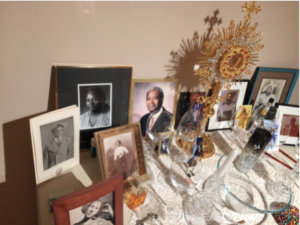 In honor of Professor Matory’s mother are several objects, among them being Object 23, which he insists to this day is the only fragrance that does not give him a headache. Similarly, Object 20 contains his mother’s favorite variety of whiskey. Yet another tribute to her is Object 19, a scaled down model of the actual automobile she owned when she was still physically on the roads. He has also added Object 24, which is again a model of a car his mother bought after finalizing her and her husband’s divorce settlement. As a tribute to his childhood memories of his mother, he has placed Object 22 on the altar to represent her method of making him cinnamon toast.
In honor of Professor Matory’s mother are several objects, among them being Object 23, which he insists to this day is the only fragrance that does not give him a headache. Similarly, Object 20 contains his mother’s favorite variety of whiskey. Yet another tribute to her is Object 19, a scaled down model of the actual automobile she owned when she was still physically on the roads. He has also added Object 24, which is again a model of a car his mother bought after finalizing her and her husband’s divorce settlement. As a tribute to his childhood memories of his mother, he has placed Object 22 on the altar to represent her method of making him cinnamon toast.
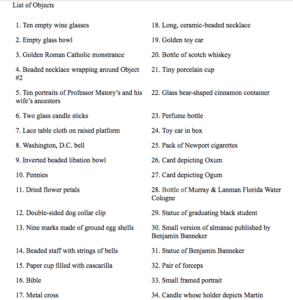 Object 12 is on the table in representation for Professor Matory’s late pet dog. This shows the relationship that humans are capable of extending into the animal world, and shows a deep love similar to that which can be felt between human family members. Other trinkets include Object 8, on which is depicted the name and monuments of Washington, D.C. This is important to Professor Matory because that is where he was raised and spent much of his childhood, presumably with many of the ancestors he is choosing to worship on this altar. Other items include Objects 10 and 11, which are used to symbolize Professor Matory’s own habit to collect things. This is possibly also a tribute to his self-proclaimed adoration for aesthetic appeal, not to mention the fact that flowers are explained to stimulate spiritual presence. Object 28 lingers at the back of the table, which was added by his altar maker. Finally, Object 25 sits towards the rear of the altar, in reverence of a deceased ancestor who used to smoke cigarettes.
Object 12 is on the table in representation for Professor Matory’s late pet dog. This shows the relationship that humans are capable of extending into the animal world, and shows a deep love similar to that which can be felt between human family members. Other trinkets include Object 8, on which is depicted the name and monuments of Washington, D.C. This is important to Professor Matory because that is where he was raised and spent much of his childhood, presumably with many of the ancestors he is choosing to worship on this altar. Other items include Objects 10 and 11, which are used to symbolize Professor Matory’s own habit to collect things. This is possibly also a tribute to his self-proclaimed adoration for aesthetic appeal, not to mention the fact that flowers are explained to stimulate spiritual presence. Object 28 lingers at the back of the table, which was added by his altar maker. Finally, Object 25 sits towards the rear of the altar, in reverence of a deceased ancestor who used to smoke cigarettes.
It is important to recognize the fact that not all ancestors who are being invoked on this altar are given equal representation. As explained by Professor Matory, he had to give more attention to paying tribute to his wife’s ancestors when constructing the altar so that there would be a more equal distribution of reverence to a diverse group of family members. As is quite evident by approaching the altar, symmetry is one of its inherent traits. Object 2, flanked by the counterparts of Object 1, which are surrounded by those of Object 5, adhere to this principle. Placed intermittently across the raised table lie all the other objects that are used to represent and honor ancestors that simultaneously pay tribute to the religions which have syncretized to form Spiritism.
Studying religion from the perspective of altars gives insight into a religion’s aesthetic importance, a key trait seen throughout all African diasporic religions. The significance of aesthetics when studying religions more broadly is seen as a way of understanding a religion’s practices and beliefs surrounding them. For example, thinking back to the Roman Catholic monstrance on Professor Matory’s altar, flamboyant and rich gold aesthetics can be seen as a trademark of the Catholic Church. This underlying idea of abundance and wealth is what backs up certain Catholic beliefs that historically have tended to favor the prosperity of the upper class, which resulted in vast accumulations of money due to taxation (Varickayil 15-16, 1980). Aesthetic emphases are apparent particularly in Spiritism, where kitsch, a particular gaudiness with a lack of artistic favorability, is argued to be a trademark component of altars (Bettelheim 312, 2005). As seen with Professor Matory, the objects comprising his Spiritist altar have personal meaning and many symbolize memories of his childhood. As Professor Matory explained, he is a collector of “beautiful things,” and his subsequent assemblage of a variety of small objects, not to mention the different cultures from which they are derived, may contribute to the aesthetic concept of “kitsch” that can be apparent to some observers. Of course, as outsiders, we must gain an adequate understanding of the value placed on the objects present on the altar. Professor Matory evidently has a very personal connection to all of these objects, and his appreciation of them adds to their capability to summon the spirits of his ancestors. Therefore, the objects themselves are all important to the study of religion, as they are crucial to successfully performing Spiritist rituals.
We can consequently learn quite a bit from observing how these objects are used in context. Materiality is a vital counterpart of many rituals and practices across different religions; in other words, the visual aspects of religion are the base for the physical acts. Without an altar or religious dress or a holy book, ritual is not as spiritually awakening. We would argue that in a more broad sense, shrines and buildings in which religious rites take place is built off the same idea. Religious space and physicality provides the necessary and authentic setting for a religion to be properly activated, initiated, and practiced. As an outsider, judgement cannot prevent a religion from acquiring its physical necessities. It is easy to see how this emphasis on materiality can be warped into a viewpoint that Spiritist altars are kitsch and that this religion “‘steals motifs and materials at random, regardless of the original ascription of the sources’” (Bettelheim 312, 2005). We must ultimately assert a higher understanding than “kitsch” aesthetics as apparent to some in Spiritist altars, and come to appreciate the significance that physical objects have for summoning ancestral spirits.
Bibliography
Awolalu, J O. “The Yoruba Philosophy of Life.” Présence Africaine Edition (1970): 20-38.
Bettelheim, Judith. “Caribbean Espiritismo (Spiritist) Altars: The Indian and the Congo.” The ArtBulletin (June 2005).
Duke University. “Beaded Walking Staff for Osain.” Accessed December 4, 2017.
Garoutte, Claire, and Anneke Wambaugh. Crossing the Water: A Photographic Path to the Afro-Cuban Spirit World. London: Duke University Press, 2007.
Johnson, Paul C. Secrets, Gossip, and Gods: The Transformation of Brazilian Candomblé. New York: Oxford University Press, 2002.
Romberg, Raquel. “Whose Spirits Are They? The Political Economy of Syncretism and Authenticity.” Journal of Folklore Research (1998): 69-82.
Santo, Diana E. Developing the Dead: Mediumship and Selfhood in Cuban Espiritismo. Gainesville, FL: University Press of Florida, 2015.
Varickayil, Robert. “Social Origins of Protestant Reformation.” Social Scientist 8 (1980): 14-31.